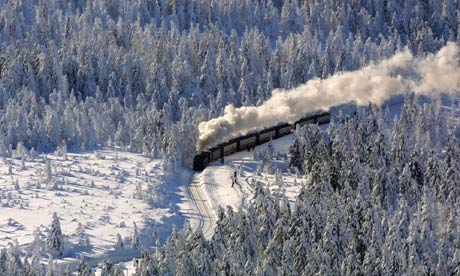
Can there be a more Christmassy book, this side of old Ebenezer's adventures with his trio of spirits, than The Box of Delights by John Masefield?
Young Kay Harker, returning from school to his family home Seekings and his festive visitors in the shape of a gang of cousins, is given the Box of the title to care for and protect by a mysterious travelling Punch and Judy man, Cole Hawlings. As is the case in these types of books, the Box is a treasure of such magnitude that by rights it should be entrusted to a private army rather than a small boy, and it isn't long before a gang of crooks with a rather magical bent, led by the dark Abner Brown, are on its trail and menacing Kay and his cousins.
So far, so fairly traditional children's fantasy. But its Christmas setting in a snowbound corner of England (with particular resonances for this very festive season - all the grown-ups conspire to be snowed in elsewhere, leaving the children pretty much alone to enjoy their travails) and the dreamy, poetic language of author John Masefield come together to make it something of a seasonal classic that certainly bears repeat readings year after year.
Dreamy and poetic … those descriptions are rather important in The Box of Delights. The novel was first published in 1935, and the author, John Masefield, was poet laureate from 1930 until he died in 1967. His prose trips along like a hallucinogenic daydream at times, especially when Kay takes advantage of the box's powers – he can use it to go swift, to go small, and to fall into the past, where he meets a succession of characters including Herne the Hunter of English folklore.
In fact, the whole book is shot through with a folklorish, mythological flavour, and even the "real" world that Kay inhabits is peopled by a cast of often eerie, mysterious, enigmatic and sometimes downright scary figures. Masefield then, at the drop of a hat, switches between his poetic descriptions and episodes that are downright fairytale-ish or Narnia-esque, with talking animals and mice armed with sewing-needle rapiers.
Masefield has a way with a well-turned, memorable sentence: "And now, Master Harker, now that the Wolves are Running, perhaps you could do something to stop their Bite?"
Dreamlike indeed, which leads us to one of the major criticisms that has been levelled at the book … I suppose I should give a spoiler warning here, but not in the sense that I'm giving any of the plot away: Rather deflatingly, we learn on the final page, it was all a dream.
A cop-out in anyone's language, but we should consider, I suppose, that in 1935 this plot device was perhaps not as hackneyed as it now seems. And all a dream? Somehow, given the magic that has infused the previous 300-odd pages of my Egmont edition, I rather doubt that Masefield meant that in the conventional sense. The Box of Delights is a dream - a Christmassy, satisfying and exciting dream of a book. And when I buy into a story in the way that I did with this one, I never fully believe that it didn't, in some way, happen. I'm glad I shared Masefield's dream, and with a big screen version on the cards, it might well become a Christmas standard for many more than me in future years.

